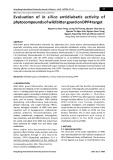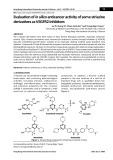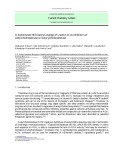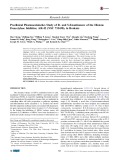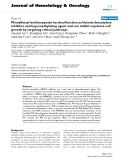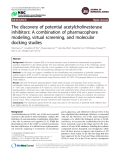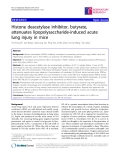
Journal of Pharmaceutical Research and Drug Information, 2024, 15: 18-25
Journal homepage: jprdi.vn/JP
Journal of Pharmaceutical Research and Drug Information
An official journal of Hanoi University of Pharmacy
*Corresponding author: Quoc Thang Nguyen; e-mail address: thangnguyenquoc1003@gmail.com 18
https://doi.org/10.59882/1859-364X/107
Research Article
2D-QSAR and molecular docking studies of hydroxamic acid derivatives
bearing Benzimidazole scaffold as histone deacetylase 6 inhibitors
Quoc Thang Nguyena,b,*, Tien Anh Duonga, Thi Mai Dung Doa, Thanh Tung Truongc, Hai Nam
Nguyena
aFaculty of Pharmaceutical Chemistry and Technology, Hanoi University of Pharmacy, 13-15 Le Thanh Tong,
Hanoi, Vietnam
bNuclear Medicine and Radiology Department, Vinmec Times City International Hospital, 458 Minh Khai,
Hanoi, Vietnam
cFaculty of Pharmacy, PHENIKAA University, Nguyen Trac, Hanoi, Vietnam
A R T I C L E I N F O
A B S T R A C T
Article history
Received 11 Oct 2023
Revised 29 Jan 2024
Accepted 9 Feb 2024
In this study, 2D-QSAR analysis and molecular docking were
performed to investigate the relationship between the hydroxamate-
based HDAC inhibitors with benzimidazole scaffold and the activity
toward HDAC6. A dataset of 55 N-hydroxybenzamide, N-
hydroxypropenamide derivatives containing benzimidazole structure
with HDAC6 in vitro activity were collected. The MLR (multiple
linear regression) method was used to build a 2D-QSAR model when
internal (leave-one-out cross validation) and external validation were
also tested. In addition, the molecular docking study was performed
by using MOE 2008 software to validate the affinity of the inhibitors
at the active site of HDAC6 enzyme (PDB ID: 5EEN). The model
was developed using 7 molecular descriptors from 55 compounds
with results of R2 = 0.905, RMSE = 0.343 and the concordance
correlation coefficient (CCC) = 0.950. The molecular docking results
also demonstrated the favorable binding interactions of compounds
into the active site on the structure of HDAC6 and the essential
residues in the pocket and the key interactions of benzimidazole ring
with these residues. Notably, the study enables a reliable model to
predict the inhibition activity of new benzimidazole-containing
inhibitors in HDAC6.
Keywords
QSAR
Molecular docking
Histone deacetylase inhibitor
Benzimidazole
Introduction
HDAC6 is a unique member of the histone
deacetylase (HDAC) family that regulates the
acetylation and deacetylation of histones and non-
histone proteins, such as α-tubulin, cortactin, and heat
shock protein 90 (HSP90) [1]. HDAC6 is essential for
several cellular functions that are involved in cancer
development and progression, such as cell









